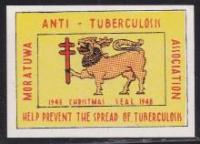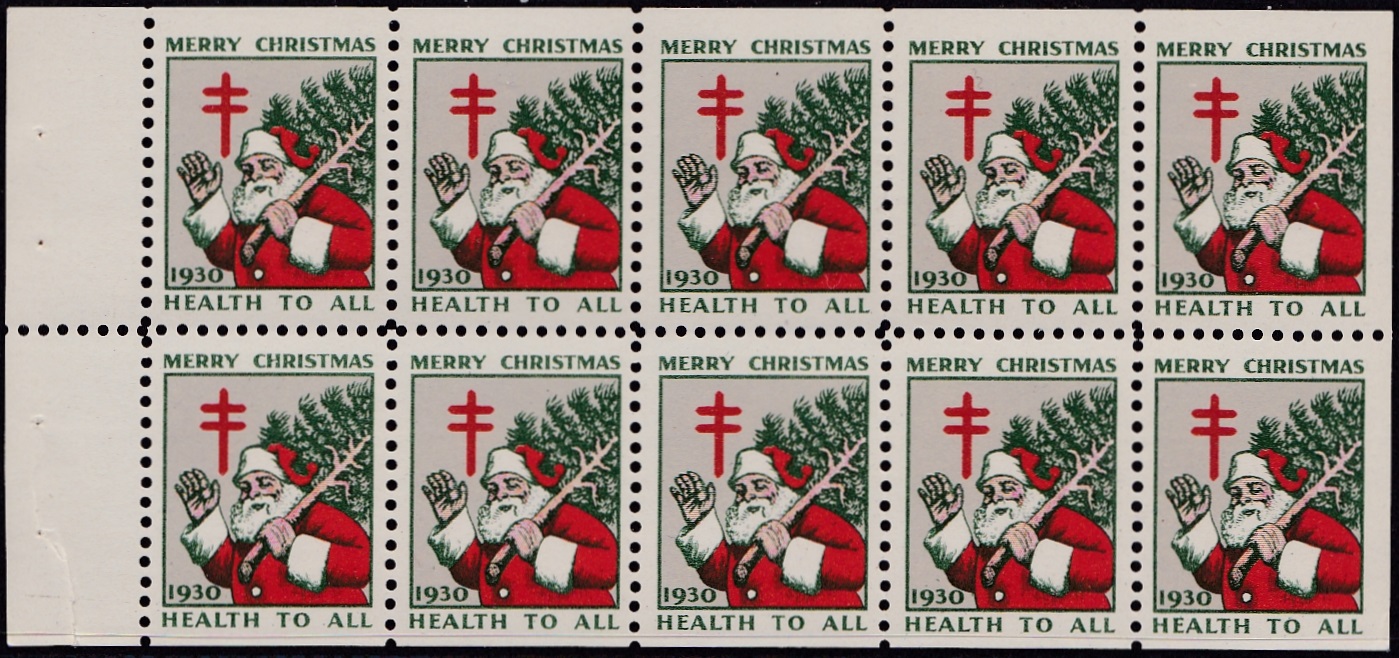
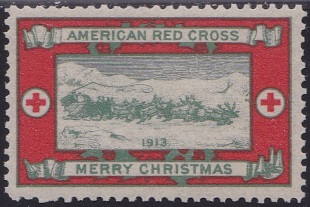
1930 US Christmas Seal booklet pane 1913 type 2 US Christmas Seals, EF centering
US Christmas Seals
Originally affiliated with the Red Cross, America's Christmas Seal Association has changed it’s name over the years, and is now The American Lung Association. Their first Christmas Seal was issued in 1907 at a time when tuberculosis was a major cause of death in America. As an effort to save a small tuberculosis hospital in the state of Delaware, Emily Bissell designed and financed this first Christmas Seal. Inspired by an article about similar project in Denmark three years earlier, her Christmas Seal was failing to receive the attention necessary to raise the needed funds. Bissell, a writer, poet, and socially conscious woman sought the help of a big city columnist, Leigh Mitchell Hodges. With the Philadelphia North American's help her financial goal was exceeded by 1000%. Sales were so brisk that even toward the end of the holiday season a second printing, a type two with “Happy New Year” added, was produced.
Call (217) 787-5864 to have your name added to the American Lung Association Christmas Seal mailing list.
US Christmas Seal Association Name Changes
- 1907 - American Red Cross, Delaware Chapter
- 1908 through 1910 - American Red Cross
- 1911 through 1917 - Sponsored and publicized by the American Red Cross, but sold by the National Association for the Study and Prevention of Tuberculosis
- 1918 - American Red Cross; given to those who joined the Red Cross Roll Call
- 1919 through 1968 - National Tuberculosis Association
- 1969 through 1972 - National Tuberculosis and Respiratory Disease Association
- 1973 onward - The American Lung Association.

Early Lutheran Sanatarium US Local TB Seals
US Local TB Seals
Local TB Seals issued at Christmas time, in the US, and all over the world, are fundraising seals issued on a city, county, state, or targeted basis. In the US, several dozen were issued between 1907 and 1908 by eight different societies in seven different states. The longest running US Local TB society is Lutheran Sanatorium, Wheat Ridge, Colorado, whose first seal was issued in 1910, and they are still issuing seals. Whether the funds were used for diagnosis, treatment, education or building, Local TB seals are created to aid local, or targeted projects (in this case, Lutherans). In Green's Catalog, the Bible of US Christmas Seals, and US and Worldwide national and local TB Seals; the local TB seals always follow the National TB seals, or those with national distribution.
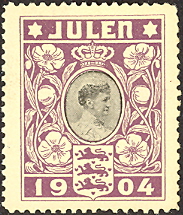
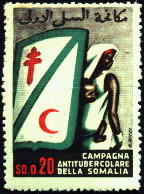
Denmark #1, Somalia, Ceylon (Sri Lanka)
Worldwide TB Seals
The world’s first tuberculosis Seal issued at Christmas time was Denmark 1904, conceived by Danish postal worker Einar Holboll. Though there were tuberculosis seals issued before 1904, Holboll is credited with conceiving the idea of a TB seal issued at Christmas time, during the season of giving. Holboll’s plan was approved by the Postmaster and the King of Denmark. Seals then spread quickly throughout Scandinavia and every major country in Europe, and are still popular today. TB seals have been issued by hundreds of different societies, nationally, and locally in Africa, Asia, Canada, Caribbean, Central America, Europe, Mexico, Middle East, Oceania, and South America. The vast majority of all TB seals since then were issued at Christmas time and included the international symbol against TB, the double barred cross of Lorraine.

"S" Strobridge printer's mark on seal #56 of 1938 US Christmas Seal sheet
Collecting US Christmas Seals
Many collectors begin with a simplified Christmas Seal collection consisting of one Christmas Seal a year. Since the biggest part of your investment is in the first ten years it doesn't cost a lot more to collect the later years in se-tenant multiples, as required. For example, it takes a pair of seals to complete the 1936 design, a block of 4 in 1954, and full sheets in 1970, 1975-80, 1995, 1996, and 1998. Many collectors of US Christmas Seals start with my 41 page Christmas Seal album. This album is free on computer CD, and provides spaces for singles, pairs, blocks, slogan blocks, booklet panes, and full sheets, as required; as well as both types of the first year, 1907. This album can be filled thru 2013 for $155.00
My specialized US Christmas Seal Album, thru 2007 is 170 pages and costs $33.00, and the CD editoion is free. It is the only album of its kind providing spaces for perforation and type varieties, US lookalikes, perforated proofs and essays, etc. For a complete description and sample pages of these and my other albums, go to Christmas Seal Albums.
Some collectors prefer full sheets which show the whole picture, including sheet format, Union Label, and Printer's Mark. For many years a tiny letter on seal #56, a Printer's Mark indicated what firm produced the sheet. Normally, the same perforation was used by multiple printers, so without a Printer's Mark, it is impossible to identify the manufacturer. Collecting Printer's Mark blocks are a way of knowing who printed the seals, without collecting full sheets.
Many Collecting Areas
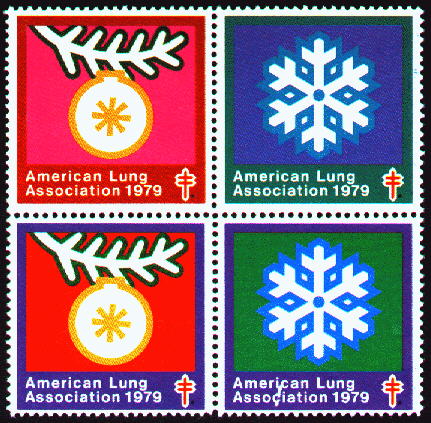
1979 T4 Snowflake Design
Design experiment Christmas Seals were first issued in 1979. They are used in test markets to determine the best design for the national issue the following year. Since 1981, the nationally issued Christmas Seal looks very much like a previous year design experiment, with one notable difference being the date.
1985 Gold Foil
Silver and Gold Foil Christmas Seals were first issued in 1985. Foil had been used in the 1930’s on some Christmas Seal essays, as well as foreign TB Seals, but the 1985 foil Christmas Seals were intended for larger donors. Gold foil was discontinued after the first year, and by 1991, silver ink was added. A dull silver ink background may have been less expensive to print and nearly replaced foil, and was eventually used on some Spanish text, and design experiment sheets. Silver ink was used on the national Christmas Seal issues in 1994 and 1995. In 2002 a new type of foil came into use. As shiny as ever, this new, perhaps thinner, foil did not curl or separate at the perforations, and has been used extensively ever since.
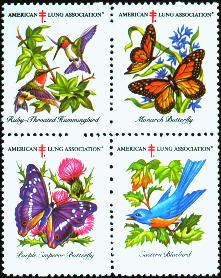
1992S-4 butterflies and birds
Spring issue Christmas Seals were first issued by the American Lung Association in 1987, these seals are undated but listed in Green's Catalog, Part 1, US Christmas Seals, and have been issued ever since. Collectors speculated that the 1991 Stylized flower issue (Green’s #91-S6), a modern rarity, was withdrawn because it looked too much like some of the flowers seen on Easter Seals.
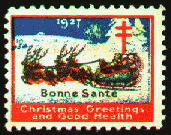

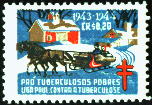
1927 French Canada with "Bonne Sante" overprint, 1952 Ryukyu with Japanese character overprint, 1943 Brazilian unauthorized lookalike copying 1942 design
Most US Lookalike Christmas Seals were printed in the USA for distribution in foreign countries and commonwealths, including Bermuda, Canada, Nicaragua, Puerto Rico, and the Ryukyu Islands. US designs, when officially borrowed, were used the same year. When unofficially borrowed by foreign TB, or US local TB societies, the design was used a later year, and do not look quite as much like the original they copy. These are known as unauthorized lookalikes.

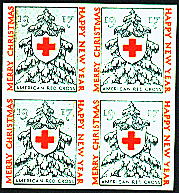
1983 Spanish text Christmas Seal, 1917 imperforate block of 4
Beginning in 1982 Spanish Text Christmas Seals have been used in all Spanish speaking parts of the USA. Imperforate Christmas Seals are not provided with any means of separation, and therefore have to be cut apart with scissors. They should always be collected in pairs, or larger multiples as required, to eliminate any question that they were perforated seals, with the perforations trimmed off.
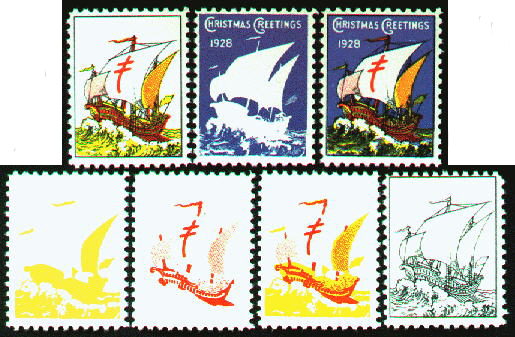
1928 progressive color proof set
Christmas Seal Progressive Color Proofs are trial impressions of one or more of the separate plates used in color printing. They are usually issued in sets of 7 and show colors separately and in combination, leading up to the complete design.
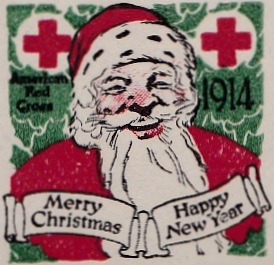
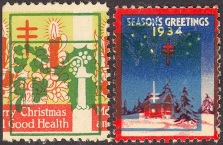
1914 US Christmas Seal Essay, 1925 & 1934 inverted color Christmas Seal Errors
Christmas Seal Essays are trial designs different from those accepted and regularly issued. Christmas Seal Freaks include mis perforated seals, colors printed out of register, offset ink on the gum side, and printer's waste. Even though seals have some things in common with postage stamps, fundraising seals were not printed with the quality control used by security printers of postage stamps, so many varieties of freak printings exist, and most have not been cataloged.


1907 HPIV (Horizontal pair imperforate vertically) Christmas Seal Error, 1920 missing color Christmas Seal Error
Christmas Seal Errors include horizontal or vertical pairs imperforate between, missing or inverted colors, etc.
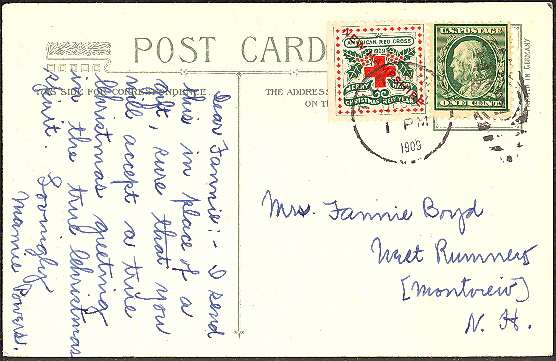
1909 New Hampshire overprint US Local TB seal Tied On postcard
Christmas Seals, along with postage stamps, tied on covers or postcards by a postmark, are known as Tied Ons. To be properly tied, the postmark ties the seal on and matches the date of the seals issue. Due to the early popularity of postcards, most early Christmas Seal tied ons are on postcards.
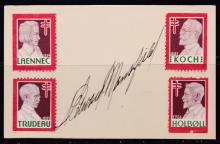
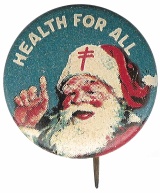

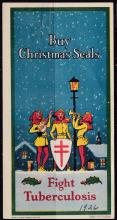
1938 Designer Autograph, Christmas Seal Button, Christmas Seal Publicity Poster Stamp, 1926 Christmas Seal Package Insert
Over the years, Christmas Seal collectors have taken an interest in all sorts of Related Material. Most of these were issued to publicize the annual Christmas Seal Campaign; including Christmas Seal designer's autographs, bonds, booth envelopes, buttons, ceramic mugs, trivets & coasters, counter displays, CS&CSS meetings, electrotypes, greeting cards, lantern slide, letterhead, menu labels, milk bottle collars, napkins, NTA annual meetings, package inserts, pamphlets, placemats, posters, publicity, sales folders, scarfs, unlisted & skeleton programs, window labels, etc.
Specialized collecting by country or a single year of Seals allows the collector to go into much greater depth. Renowned philatelist John Hotchner was one of the first to exhibit his single year collection of 1934 US Christmas Seals in competitive stamp shows. Many others followed. The effort of seal collectors is one of the reasons why Christmas Seal exhibits, once not eligible for awards, now receive them regularly at APS shows.
Topical collecting is a way many have branched out into seals. Most topical seal collectors start out collecting stamps, and as they became more advanced discovered seals. I recently wrote a list of Santa Claus on seals, which I believe is near complete. I would love to see a topical index of US and worldwide Christmas Seals. This is one of many important projects waiting on a volunteer.
Many US Christmas Seals, and US local, and worldwide TB seals, have been issued in booklet panes which usually have interesting information, images, and sometimes advertisements printed on the covers. Italy’s 2nd national TB seal issue released in 1932 in booklet form, has an advertisement on the cover for cigarettes. Even in 1932, many people must have thought that smoking was not compatible with fighting lung disease, but it makes a great conversation piece.
Christmas Seal Terms and Abbreviations
Green's Catalog numbers can be long and confusing, for example 1949-3x is a sheet of 1949 seals printed by the 3rd printer listed, which is Edwards and Deutsch Litho.; 1940NMp1 is a 1940 Negative Maker's proof, variety 1, which is imperforate
- E - essay, a proposed design
- HBg - horizontal broken gum, a horizontal diamond pattern impressed in the gum to prevent curling
- imp, imperf - imperforate
- NG - no gum, usually with the gum removed, but occasionally issued without gum for a tropical climate
- NM - negative maker's proof, a true printer's proof
- p - proof, usually imperforate
- pcp - progressive color proof, usually a set of 7 stages showing colors separately and in combinations, leading up to the complete design.
- P4S - perforated on all four sides
- perf 12:00x12 - horiz rows of perfs are perf 12, with 2 larger diameter perf holes at intervals; usually 11 regular perf 12 holes are between pairs of larger holes.
- PM - perforated margin
- pm - printer's mark. Since 1936 printer's used a tiny letter on seal #56, on sheets of 100, to identify their product.; "E" Eureka Specialty Printing Co., "S" Strobridge Litho. Co. 1930-58, Specialty Printers of America 1975-92 "D" Edwards and Deutsch Litho. Co., "U" U.S. Printing and Litho. Co., "F" Fleming-Potter Co., etc.
- r.9, roul.9 - roulette 9
- S - Spring issue
- SE - straight edge
- SE 4S - straight edge on all 4 sides of a sheet
- Sg - smooth gum
- SqBg - square broken gum - a square pattern impressed in the gum to prevent curling.
- T - test seal, usually a design experiment
- TB - tuberculosis
- UK - unknown printer
- UL - Union Label, like printer's marks, these can be used to identify sheets.
- VBg - vertical broken gum, a vertical diamond pattern impressed in the gum to prevent curling.
- VM - varying margin; a margin made when a cut separates a perforated press sheet into smaller sheets or panes. Depending on where the knike cut chances to fall, such a margin will be a narrow PM, SE, or perforated edge. From 1932-62 Eureka sheets have a VM on two sides of the sheet.
- x - sheet

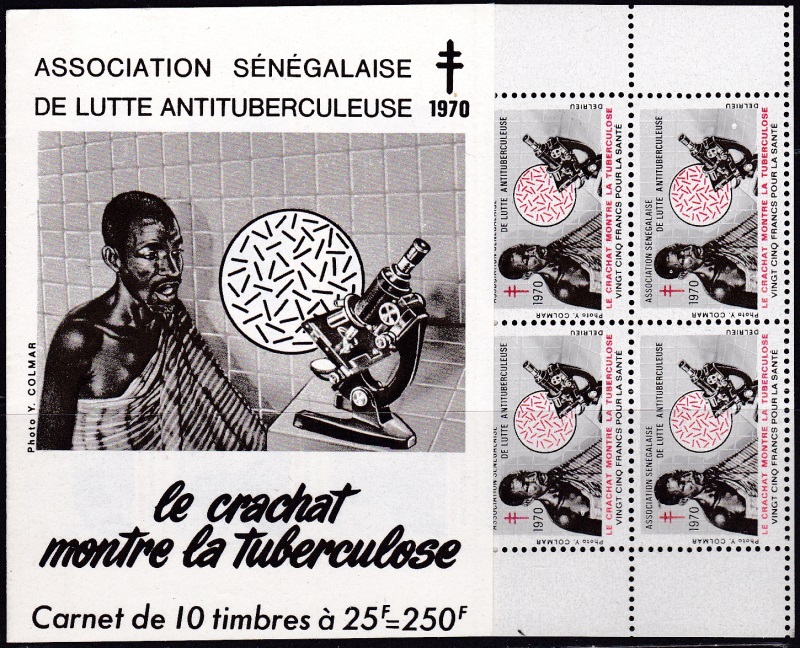
1984 Portugal TB, 1970 Senegal TB
More on Tuberculosis
TB, also known as consumption, or phthisis is an infectious disease present in humans since antiquity, and is responsible for more deaths in the last 200 years than any other disease. Before the Industrial Revolution, folklore associated it with vampires. When one member of a village died, others in the community would slowly lose their health, it was believed, because the deceased was draining the life from them. Caused by bacteria, Mycobacterium tuberculosis, TB was identified in 1882 by German Dr. Robert Koch, the founder of modern bacteriology. His work with TB won him the Nobel Prize in 1905. The disease is passed through the air, and those with active TB require isolation. Many of the sick were confined to sanatoriums, hospitals designed to treat TB patients.
As TB ravaged the west, The "Crusade to Eradicate" the disease grew by leaps and bounds, and Christmas Seals were on the front line of this war. Since the late 40’s, with a combination of antibiotics, doctors nearly eradicated TB from the west. As TB became less of a public health problem Christmas Seals branched out into other lung diseases, including asthama, and emphysema. Of course, most lung disease today is the result of smoking.
Even today, one third of the world’s population shows positive for TB, and ten percent of those people will become sick at some point in their lives. Multi drug resistant TB or MDR TB, and the even more serious, extensively drug-resistant TB or XDR-TB has shown up in the developing countries where AIDS has reduced the populations immunity. Caused by inappropriate treatment of TB, or patients missing doses or failing to complete their treatment, these are a serious threats to the world health.
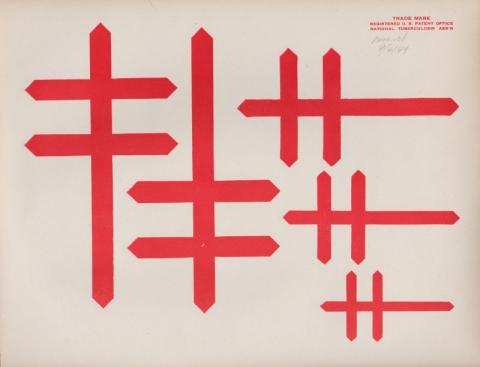
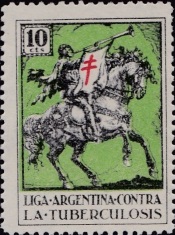
1944 Double Bar Cross sheet issued by the National TB Association, Argentina TB
The Double Barred Cross
Most tuberculosis seals include the red double-barred "Lorraine" Cross, adopted by most countries as the international symbol of the crusade against TB. First suggested in 1902 by Paris physician Gilbert Sersiron as a symbol for the "crusade" against tuberculosis, this cross was added to US National Christmas Seals in 1919, and has been used ever since.
The double barred cross was originally the coat of arms of Godfrey of Bouillon, Duke of Lower Lorraine, a leader of the first crusade and elected ruler of Jerusalem after its capture in 1099. To prevent their possible collusion with the Crusaders, Christians had already been expelled from the city. Jews fought side-by-side with Muslim soldiers to defend Jerusalem, and few were spared. Godfrey refused the title of King on religious grounds, and was designated, Advocatus Sancti Sepulchri, or Defender of the Holy Sepulcher. Godfrey was distinguished for his piety and simplicity. As the first Latin ruler of Jerusalem, he became the central figure of various legends, and his deeds were glorified in the chansons de geste. According to Arabic history, Godfrey was killed while besieging the city of Arce in 1100. His brother, Baldwin I, succeeded him as ruler of Jerusalem and took the title, king.
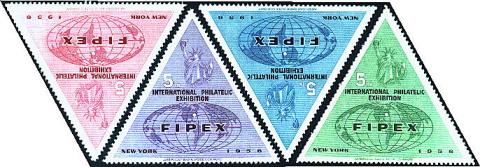
1956 FIPEX Philatelic Event Seals engraved by the American Bank Note Company
Cinderellas
There is a lack of published information on most Cinderellas, but US Christmas Seals, US Local TB, Worldwide TB, US All Fund, and Worldwide Red Cross seals are well cataloged, and though they are Cinderellas, they are listed in separate sections of my website.
"Cinderella" is a stamp collecting term which means virtually anything that looks like a stamp but does not have postal validity. A Cinderella stamp can not carry the mail. Like the fairy tale character who was not allowed to attend the royal ball, a Cinderella stamp is not permitted to be exhibited at a FIP (World Federation for Philately) stamp show. Despite her wicked step mother's rules, Cinderella managed to sneak in. The American Philatelic Society has a Cinderella category in their competitive stamp show exhibitions. Times are changing! Alan Moll won a large vermiel award for his Wheatridge US Local TB exhibit at NY 2016, so the FIP seems to be softening their stance against cinderellas.
My Cinderella section contains non TB Danish, Swedish, Finnish, Norwegian, Icelandic funds, as well as Souvenir Cards, Mike Bean Engravings, Philatelic Literature, Air Baggage Labels, and Topical TB Seals.
More Cinderellas in my Store, include revenues and reprints; poster stamps issued for advertising products or tourism; events, such as worlds fairs, philatelic exhibitions, olympics; patriotic labels; political labels; local posts, etc.

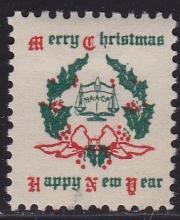

1934 #1 Easter Seal, NAACP, American Legion
All Fund
Ray Mosbaugh's US All Fund Catalog lists fundraising seals issued for causes other than tuberculosis or Red Cross, and is divided into ten sections: 1) Patriotic & Veteran, 2) Civic & Fraternal, 3) Catholic, which Boystown is a part of, 4) Lutheran, 5) Religious & Philosophical, which American Bible Society is a part of, 6) Jewish, 7) Ethnic, which NAACP is a part of, 8) Pets, Plants & Wildlife, which National Wildlife Federation is a part of, 9) Medical, which Easter Seals are a part of, and 10) Miscellaneous. which Starr Commonwealth is a part of.

1944 Belgian Red Cross, postcard like folder
Red Cross
Red Cross fundraising seals, listed in Ray Mosbaugh's Red Cross Seal Catalog, have been issued worldwide. The Red Cross was founded in 1869 in Switzerland by Henry Dunant, who called for international agreements to protect the sick and wounded during wartime without respect to nationality. Their symbol, a white cross on a red field, was the opposite of the Swiss flag. In 1881, Clara Barton founded the American Red Cross and led it for the next 23 years. During the Civil War, Barton saw a great need and began taking supplies to the young men of the Sixth Massachusetts Infantry who were temporarily housed in the unfinished Capitol building.
Other Collectables
Not related to Christmas Seal collecting, but things I love, or have just picked up along the way.
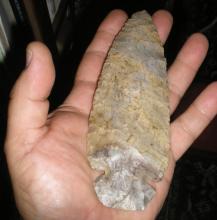
The best piece I ever owned -Archaic Dovetail, Flint Ridge Flint, 6+ inches - sold
Authentic Ohio Indian Artifacts
I found my first arrowhead when I was a boy visiting my grandfather’s tobacco farm in Jackson County, Ohio. Years later, after developing an interest in ancient coins, I came to the conclusion that I was surrounded by an incredible Stone Age culture that spanned from Paleolithic to Woodland times. It is amazing the way Native American cultures, over the millennia, developed chipping techniques and preferred certain materials. Even though every piece is unique, a trained eye can easily recognize different types. Central Ohio is the heartland of Adena and Hopewell culture, but artifacts from all periods are found here. My home in Newark is located roughly between two of the most important Hopewell ceremonial mounds in Ohio, the Great Circle, and the Octagon. The most famous Indian quarry, Flint Ridge, is here in Licking County. I have developed a modest collection, and my wife decided I could go no further until I attempted to sell some of them. I price them based on what I paid, not what some others have asked, and sales have been good. My inventory includes individual items, as well as collections. Everything I sell has a guarantee of satisfaction, so you can show the piece around after you get it, and return it if it doesn't suit you.
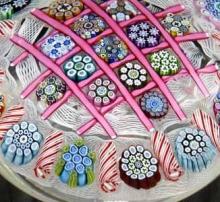
Detail of Peter McDougall millefiori weight
Glass Paperweights
When I was a boy in the 1960's dad studied about and collected paperweights, eventually purchasing a large lot of seconds from the St. Clair Glass company in Elwood, Indiana. On numerous car vacations (Dad was a traveling motorcycle parts salesman for Dixie Distributing) we occasionally met famous paperweight makers, such as Charles Kaziun at his home in Brocton, Massachusetts, the Father of the American Paperweight Renaissance. Kaziun purchased some of Dad's St. Clair seconds. Later, in the early 70's on a trip to Scotland, we visited the Strathearn, Perthshire and Caithness factories, and went on to meet Paul Ysart at his studio. I began seriously collecting them only a few years ago, and have an interest in Baccarat paperweights, as well as individual artists, all among the top paperweight makers in the world; William Manson, Michael Hunter, Allan Scott, John Deacons, and Peter McDougall, all living and working in Scotland. My first American artist is the remarkable Clinton Smith. Most of these artists create lamp work paperweights, but are also very well known for their millefiori paperweight canes. I also have an interest in Crimp Rose paperweights, first produced in Millville, NJ.
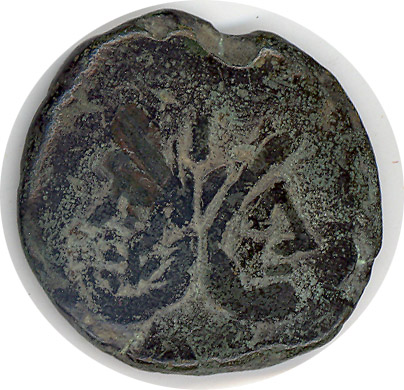
Roman Republican Coin
Ancient Coins
These bits of history are dug up all over Europe, Africa and Asia, and tell great stories of the distant past. Used in places that would seem exotic to us today, and occasionally issued by insane emperors. They often depict strange gods, and deified men. The Romans, operated mints from Britian to the Middle East and North Africa. After the fall of Rome in the west, they continued on as the Byzantine Empire in the east. The earliest ones are Greek, from 6th century BC, but some Chinese coins may be as old. Some of my favorites are the enemies of Rome, such as the Parthian and Sassanian Empires. It is interesting that the earlier coins showed remarkably better artistry than the later coins of the Medieval world. Some ancient Indian coinage had Greek and Sassanian connections.
